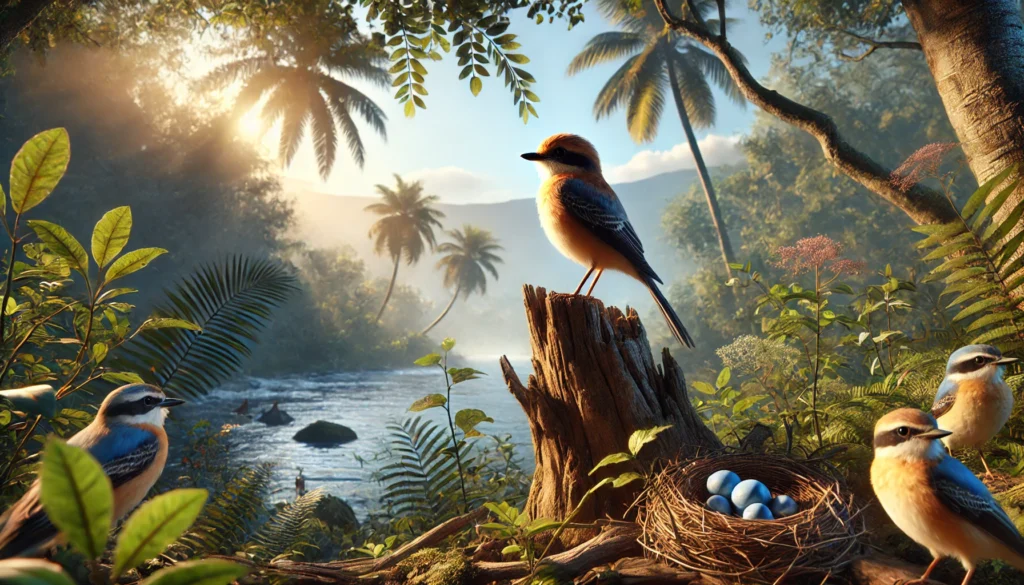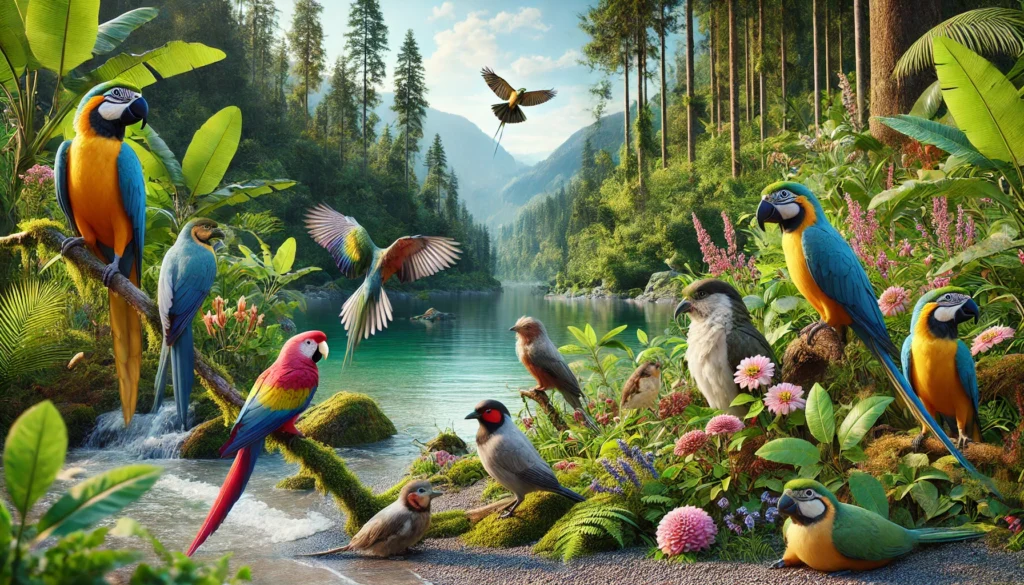Imagine yourself walking through a lush forest, where the sun's rays filter through the treetops and the air is filled with a symphony of melodious songs. Suddenly, you see a vibrantly colored bird, with feathers that look like they were painted by hand. The feeling of wonder when seeing this creature in its natural habitat is indescribable. Wild birds are not only a feast for the eyes, but they also play vital roles in ecosystems around the world. As a biologist specializing in wild and exotic animals, I invite you to embark on this fascinating journey to discover the 10 most beautiful wild birds in the world and their habitats.
1 – Blue Peacock (Pavo cristatus)
The blue peacock, with its iridescent feathers and famous colorful fan, originates from the forests of India and Sri Lanka. This stunning bird not only displays its beauty during the mating season but also plays a crucial role in Indian culture and mythology. Mainly living in open forest areas and fields, the blue peacock uses its plumage to intimidate predators and attract mates. Their loud, distinctive calls are a reminder of the complexity and beauty of nature's sounds.
2 – Blue Macaw (Anodorhynchus hyacinthinus)
The blue macaw, the largest species of macaw, is a true icon of the tropical forests of South America, especially in Brazil. With vibrant blue plumage and a powerful beak, this bird is both majestic and endangered. The Hyacinth Macaw's habitat includes humid forests and palm groves, where it feeds mainly on seeds and fruits. The conservation of these birds is vital, as they play an important role in seed dispersion, contributing to forest regeneration.
3 – Resplendent Quetzal (Pharomachrus mocinno)
In the cloud forests of Central America lives the resplendent quetzal, a bird revered for its beauty and cultural symbolism. With its iridescent green feathers and long pair of tail feathers, the quetzal is a rare and precious sight. These birds depend on high-humidity habitats and are indicators of the health of tropical forests. Unfortunately, habitat loss and illegal hunting threaten the quetzal's survival, making protecting its forests an urgent priority.
4 – Flamingo (Phoenicopteridae)
Flamingos, with their bright pink feathers and long, elegant legs, are iconic inhabitants of salt lakes and wetlands around the world. These filter-feeding birds get their distinctive color from their carotenoid-rich diet, which includes algae and small crustaceans. Species such as the Caribbean flamingo and the Andean flamingo can be found in tropical and subtropical regions, where they gather in large colonies. Preserving their aquatic habitats is crucial to the survival of these spectacular birds.
5 – Bird of paradise (Paradisaeidae)
In the rainforests of New Guinea and neighboring islands, birds of paradise exhibit some of the most impressive diversity of shape and color in the animal kingdom. With elaborate dances and plumage that looks like something out of a fairy tale, these birds are a testament to the creativity of evolution. Each species of bird of paradise has a specific habitat, ranging from lowland forests to high altitudes. Conservation of these forests is vital to protect these living jewels of nature.
6 – Common Kingfisher (Alcedo atthis)
The common kingfisher, with its bright blue and orange feathers, is a master fisher in the shallow waters of rivers and lakes in Europe and Asia. This agile and precise bird dives to capture small fish and aquatic invertebrates, displaying incredible skill. Kingfishers are important indicators of water quality in their habitats, highlighting the need to preserve clean and healthy aquatic environments.
7 – Toco Toucan (Ramphastos toco)
The toco toucan, with its huge and colorful beak, is an unmistakable symbol of the tropical forests of South America. This beak, although it appears heavy, is surprisingly light and useful for reaching fruits on inaccessible branches. Toucans play a crucial role in dispersing seeds, helping to regenerate forests. Protecting their habitat is essential to maintain the ecological balance of these regions.
8 – Ruby Hummingbird (Archilochus colubris)
Hummingbirds are true miracles of nature, and the ruby hummingbird, with its iridescent feathers and ability for precise flight, is one of the most fascinating. Found mainly in North America, this small bird feeds on flower nectar and plays a vital role in pollination. Hummingbird habitats range from forests to urban gardens, demonstrating their adaptability. The conservation of native plants and flowering habitats is fundamental to the survival of these incredible aviators.
9 – Ecletus parrot (Eclectus roratus)
The ecletus parrot, with striking sexual dimorphism, where males are bright green and females red and blue, is native to the forests of New Guinea and neighboring islands. This parrot prefers tropical forest and mangrove habitats, where it feeds on fruits, nuts and seeds. Its beauty and intelligence have made it a favorite among bird lovers, but illegal trapping and habitat destruction threaten its wild populations.
10 – Pink cockatoo (Eolophus roseicapilla)
The pink cockatoo, with its soft pink and gray plumage, is a common sight in arid and semi-arid regions of Australia. Known for its sociable and playful personality, this bird forms large flocks and feeds on seeds and vegetation. Pink cockatoo habitats include woodland, grassland and agricultural areas, where they are adaptable and resilient. Conservation of these environments is essential to ensure these enchanting birds continue to thrive.

The importance of habitats for the survival of birds
The preservation of natural habitats is essential for the survival of wild birds. These environments not only provide food and shelter, but are also fundamental to the reproductive and social behavior of these species. Habitat destruction due to deforestation, urbanization and climate change has a devastating impact on bird populations, many of which are already at risk of extinction.
Tropical florests
Tropical forests are some of the most biodiverse habitats on the planet. They are home to numerous species of birds, including the hyacinth macaw and the resplendent quetzal. These birds depend on the dense tree canopy and abundance of fruits and insects that these forests provide. Conservation of these areas is vital not only for the birds, but also for the overall health of our planet, as rainforests play a crucial role in regulating the global climate.
Wetlands
Wetlands, such as swamps, lakes and estuaries, are critical habitats for many bird species, such as flamingos. These areas provide an abundance of food resources and are important locations for breeding and migrating waterfowl. Pollution and drainage of these areas for agriculture and urban development threaten the survival of many bird species that depend on these wetlands.
Mountainous Regions
Mountainous regions offer unique habitats for birds like the resplendent quetzal. Cloud forests and mountain valleys are areas rich in biodiversity and provide refuge for many threatened species. However, mining, deforestation and climate change are putting pressure on these fragile ecosystems. Protecting mountainous regions is essential for conserving global biodiversity.
Deserts and Savannas
Deserts and savannas, despite appearing inhospitable, are home to several species of birds adapted to these arid environments. The pink cockatoo and toco toucan are examples of birds that thrive in savannas and semi-arid areas. These birds play important roles in seed dispersion and maintaining the ecological balance of these ecosystems. The conservation of savannas and deserts is essential for the survival of these species and for the health of the ecosystems where they live.

Conclusion
Exploring the beauty and diversity of the world's wild birds is a truly enriching experience. Each of these birds, from the stunning blue peacock to the enchanting pink cockatoo, not only captivates our senses but also plays crucial roles in their respective ecosystems. Protecting their habitats is essential to ensure that these wonders of nature can be enjoyed by future generations. Whether in the dense rainforest or the vast savannas, each bird contributes to the vibrant, interconnected tapestry of life on Earth.
Common questions
What are the main threats to wild birds?
Major threats include habitat destruction, illegal hunting, animal trafficking and climate change, which affect food availability and nesting sites.
How can I help conserve wild birds?
You can support conservation organizations, reduce the use of products that contribute to habitat destruction, plant native vegetation, and promote education about the importance of wild birds.
Can wild birds be kept as pets?
Although some birds can be legally kept as pets, many wild birds are protected by laws that prohibit their capture and trade. It's always best to admire these birds in their natural habitats.
What is the role of birds in nature?
Birds play diverse roles, including pollination, pest control, seed dispersal, and maintaining the health of ecosystems. They are important indicators of environmental health.
Why is bird diversity important?
Bird diversity contributes to the stability and resilience of ecosystems, ensuring that multiple ecological functions are performed. Furthermore, genetic diversity helps species adapt to environmental changes.
What are some of the rarest birds in the world?
Some of the rarest birds include the hermit ibis, ivory-billed woodpecker and Mauritian pigeon, which face severe threats of extinction due to habitat loss and hunting.
